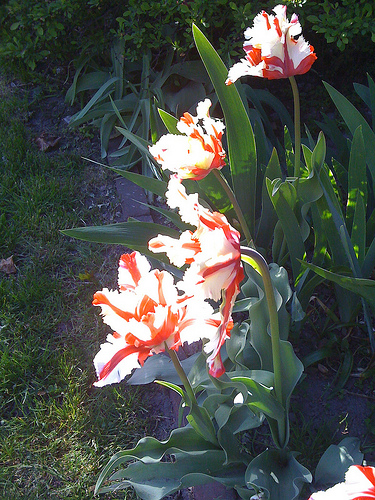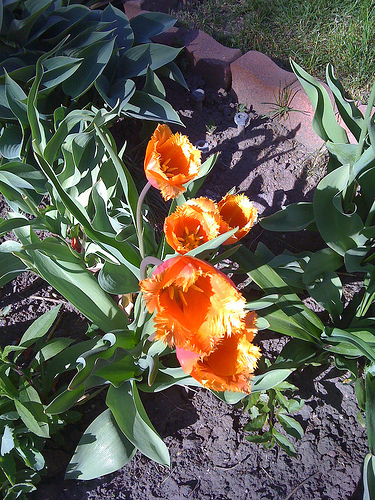We’ve had a wicked cold snap here in Ontario. This weekend Chris and I were at the cottage and it snowed! Lots! None of it really hung around but Saturday saw plenty of the white stuff falling.
Thankfully I had avoided temptation and not yet put out any of my tomatoes, despite the wonderful early-summer-like weather we’ve been getting pretty much since April (I say wonderful but I also mean unseasonably dry, which is not so wonderful). Unfortunately my colleague at work, originally from Argentina and who is very excited to plant tomatoes this year, misread my email about planting after May 2-4 to ready “after May 2nd to 4th” and lost her three tomato plants she had just planted this weekend to the frost. Sorry Paola!

I snapped these photos the other day on my way to a doctor’s appointment where there is this beautiful little flower garden out front. The building is mixed zoned with offices and residential tenants, so there is either a really talented and caring superintendent or a very committed resident taking care of this little gem. There are the most beautiful bulbs planted there that blow my mind every year.

Years ago I took a trip to Amsterdam and of course, the first thing I did was stuff my suitcase with tulip bulbs to bring back with me. All the fanciest colours and shapes. But none of them did worth a hoot.
The gorgeous red and white flame tulips above reminded me of what is largely considered to be the world’s first economic bubble — Tulip Mania — a period in the Dutch Golden Age in 1637, when the aristocracy went inexplicably gaga over tulips. Some rare bulbs, like the now extinct Semper Augustus, were fetching prices 10 times the price of a skill tradesman’s annual salary.
What made the Semper Augustus so rare, and eventually extinct, was the fact that it’s extraordinary colouring was actually the result of a virus, making the tulip very difficult to grow and weakening the bulb to the point that the plant could no longer be propagated. Some collectors even got in the habit of exhibiting their bulbs under glass cloches rather than trying to plant them, as a sign of their wealth. I’m not a botanist and for all I know the virus has been cured, but perhaps that’s still why flame tulips can be so challenging to grow. These, and their frilly parrot cousins, are stunning show stoppers that signify the end of tulip season, as they’re always the last of all tulips to put on their seasonal performance.
I love the fact tulip season has early/middle and late seasons of its own!